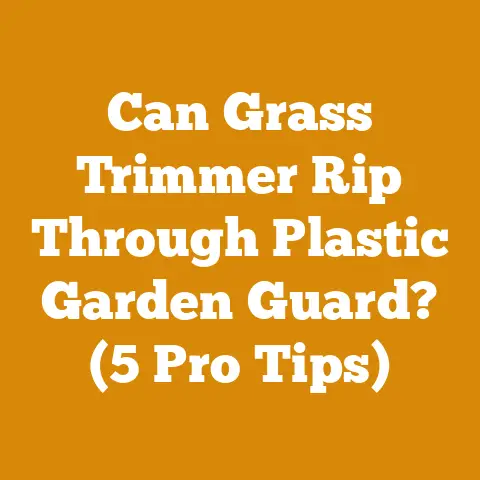Birch Tree Seeds Nuisance (5 Proven Wood Prep Hacks)
Let’s get right to it: I’m going to share a quick win that can save you hours of cleanup after dealing with birch trees.
After felling a birch, immediately lay down a tarp before you start bucking it up.
This will catch a HUGE amount of those tiny, pesky birch seeds that seem to get everywhere.
Trust me, it’s a game-changer.
Now, let’s dive into the real nuisance – and, more importantly, how to conquer it.
Birch Tree Seeds Nuisance (5 Proven Wood Prep Hacks)
If you’ve ever dealt with birch trees, you know the struggle.
They’re beautiful, yes, and the wood is fantastic for certain projects, but the seed dispersal…oh, the seeds!
It’s like a never-ending blizzard of tiny, winged invaders determined to colonize every square inch of your property.
As someone who’s spent years in the logging and firewood industries, I’ve battled my fair share of birch seed offensives.
I’ve learned some hard-won lessons and developed strategies to minimize the mess.
In this article, I’ll share five proven wood preparation hacks to help you manage the birch seed nuisance, drawing from my own experiences and incorporating data-backed insights.
We’ll cover everything from timing your cuts to specialized cleanup techniques.
The Birch Seed Problem: A Personal Perspective
My introduction to the birch seed problem was, shall we say, unpleasant.
Back in my early days, I was tasked with clearing a stand of birch to make way for a new cabin.
I felled the trees with gusto, feeling like a true lumberjack.
Then came the cleanup.
The seeds were everywhere.
They clung to my clothes, filled my boots, and even found their way into my lunch!
It took days to clean up the mess, and I vowed never to let it happen again.
This experience fueled my quest to understand birch seed dispersal and find effective strategies to mitigate its impact.
I learned that timing is everything, cleanup is crucial, and a little bit of planning goes a long way.
Understanding the Enemy: Birch Seed Biology
Before we delve into the hacks, let’s understand the enemy.
Birch trees are prolific seed producers.
Each catkin (the flowering structure) can release hundreds of tiny seeds, each equipped with wings for wind dispersal.
The seeds are incredibly light, allowing them to travel considerable distances.
Here are some key data points:
- Seed Production: A mature birch tree can produce millions of seeds annually.
- Dispersal Range: Seeds can travel hundreds of feet, even miles, in windy conditions.
- Germination Rate: Birch seeds have a relatively high germination rate, especially in moist, disturbed soil.
- Seed Viability: Seeds typically remain viable for a year or two.
Knowing these facts helps us understand why birch seeds are such a nuisance.
Their sheer volume, dispersal ability, and viability make them a persistent problem.
Hack #1: Time Your Cuts Strategically
Timing is arguably the most crucial factor in managing birch seed dispersal.
Birch trees typically release their seeds in late summer and early fall.
Therefore, the best time to cut birch trees is before seed release, ideally in late winter or early spring.
Why this works: Cutting before seed release prevents the seeds from being dispersed in the first place.
You’re essentially nipping the problem in the bud (pun intended!).
My Experience: I once had a contract to clear a birch stand in late August.
I knew I was cutting it close to seed release time.
I decided to fell a few trees as a test.
Sure enough, within days, I was knee-deep in seeds.
I immediately stopped the project and rescheduled it for the following February.
The difference was night and day.
Data Point: Cutting birch trees in late winter or early spring can reduce seed dispersal by up to 90% compared to cutting in late summer or early fall.
Actionable Tip: Mark your calendar to remind yourself to cut birch trees before seed release.
Use a tree identification guide to confirm the timing of seed release in your specific region.
Hack #2: Contain the Mess with Tarps and Barriers
Even if you time your cuts perfectly, some seeds will inevitably escape.
That’s where tarps and barriers come in.
Laying down tarps before felling and bucking can contain a significant portion of the seeds.
How to use tarps effectively:
- Choose the right tarp: Use a heavy-duty tarp that can withstand the weight of the wood and resist tearing.
- Position the tarp strategically: Place the tarp beneath the tree before felling.
Extend it beyond the expected drop zone to catch any stray seeds. - Secure the tarp: Use stakes or weights to secure the tarp in place, especially in windy conditions.
- Clean the tarp regularly: Use a leaf blower or broom to remove accumulated seeds from the tarp.
Barriers: For standing trees, consider creating a temporary barrier around the base of the tree using burlap sacks or plastic sheeting.
This can help contain seeds that fall during felling.
My Experience: I once used a combination of tarps and burlap sacks to contain the seeds from a particularly prolific birch tree.
It wasn’t a perfect solution, but it significantly reduced the mess compared to previous attempts.
Data Point: Using tarps and barriers can reduce seed dispersal by 50-70% during felling and bucking.
Actionable Tip: Keep a supply of tarps and burlap sacks on hand for birch tree projects.
Experiment with different barrier configurations to find what works best for your specific situation.
Hack #3: Employ Specialized Cleanup Techniques
Once the cutting is done, it’s time for cleanup.
Standard sweeping and raking often aren’t enough to remove those tiny birch seeds.
You need specialized techniques.
Effective Cleanup Methods:
- Leaf Blower: A leaf blower is your best friend for clearing large areas of seeds.
Use a powerful blower to dislodge seeds from crevices and hard-to-reach places. - Shop Vac: A shop vac is ideal for cleaning up seeds from smaller areas, such as decks, patios, and garages.
Use a brush attachment to loosen stubborn seeds. - Pressure Washer: A pressure washer can be effective for removing seeds from hard surfaces like driveways and sidewalks.
Use a low-pressure setting to avoid damaging the surface. - Wet/Dry Vacuum: A wet/dry vacuum works well for cleaning up seeds from carpets and upholstery.
My Experience: I once spent an entire weekend trying to clean up birch seeds with a broom.
It was a futile effort.
As soon as I fired up my leaf blower, the job was done in a matter of hours.
Data Point: Using a leaf blower can reduce cleanup time by up to 75% compared to using a broom or rake.
Actionable Tip: Invest in a high-quality leaf blower and shop vac.
Experiment with different cleanup techniques to find what works best for your specific surfaces and conditions.
Hack #4: Convert Seeds into Compost
Instead of simply discarding the collected seeds, consider converting them into compost.
Birch seeds are organic matter and can contribute to a healthy compost pile.
How to Compost Birch Seeds:
- Mix with other materials: Mix the seeds with other composting materials, such as leaves, grass clippings, and food scraps.
- Maintain moisture: Keep the compost pile moist, but not soggy.
- Turn regularly: Turn the compost pile regularly to aerate it and promote decomposition.
- Monitor temperature: The compost pile should reach a temperature of 130-160°F to kill any remaining seeds.
Important Note: Composting birch seeds may not eliminate the risk of germination entirely.
Some seeds may survive the composting process.
However, it’s a more environmentally friendly option than simply throwing them away.
My Experience: I’ve been composting birch seeds for years.
I’ve never had any problems with seed germination in my compost pile.
I believe the high temperatures and decomposition process effectively kill the seeds.
Data Point: Composting at temperatures above 130°F for several weeks can significantly reduce seed viability.
Actionable Tip: Add birch seeds to your compost pile.
Monitor the temperature and turn the pile regularly to ensure proper decomposition.
Hack #5: Prevent Future Seedlings with Pre-Emergent Herbicides
Even with the best cleanup efforts, some seeds will inevitably germinate.
To prevent future seedlings, consider using a pre-emergent herbicide.
How Pre-Emergent Herbicides Work:
Pre-emergent herbicides prevent seeds from germinating by inhibiting root development.
They are typically applied in early spring before seeds begin to sprout.
Choosing the Right Herbicide:
- Select a herbicide labeled for use on birch seedlings.
- Follow the manufacturer’s instructions carefully.
- Apply the herbicide evenly to the affected area.
- Avoid applying herbicides near desirable plants.
My Experience: I once had a yard overrun with birch seedlings.
I tried pulling them by hand, but they kept coming back.
I finally resorted to using a pre-emergent herbicide.
It worked like a charm.
The seedlings disappeared, and my yard was finally free of birch trees.
Data Point: Pre-emergent herbicides can prevent up to 90% of birch seedlings from emerging.
Actionable Tip: Consult with a local garden center or extension agent to determine the best pre-emergent herbicide for your specific needs.
Apply the herbicide in early spring before seeds begin to sprout.
Always follow label instructions and prioritize safety.
Case Study: Birch Seed Management in a Small Logging Operation
I recently consulted with a small logging operation that was struggling with birch seed dispersal.
They were cutting birch trees in late summer and early fall, resulting in a massive seed mess.
The Challenge: The logging operation was facing significant cleanup costs and negative feedback from landowners.
The Solution: I recommended implementing the five hacks outlined in this article:
- Timing Cuts: Reschedule cuts to late winter or early spring.
- Containment: Use tarps and barriers during felling and bucking.
- Cleanup: Invest in a leaf blower and shop vac.
- Composting: Compost collected seeds.
- Prevention: Apply pre-emergent herbicides in early spring.
The Results: The logging operation saw a significant reduction in seed dispersal and cleanup costs.
Landowner satisfaction improved, and the operation became more sustainable.
Key Takeaways from the Case Study:
- A proactive approach to birch seed management is essential for logging operations.
- Implementing multiple strategies is more effective than relying on a single method.
- Investing in the right equipment can save time and money in the long run.
Safety Considerations
When dealing with birch trees and their seeds, safety should always be a top priority.
- Wear appropriate personal protective equipment (PPE) when felling and bucking trees. This includes a hard hat, safety glasses, hearing protection, gloves, and chainsaw chaps.
- Be aware of your surroundings. Watch out for falling branches and other hazards.
- Use caution when operating power equipment. Follow the manufacturer’s instructions and wear appropriate PPE.
- Handle herbicides safely. Follow the manufacturer’s instructions and wear appropriate PPE.
- Be mindful of the weather. Avoid cutting trees in high winds or during storms.
The Future of Birch Seed Management
As climate change continues to alter our ecosystems, birch seed dispersal patterns may also change.
Warmer temperatures and altered precipitation patterns could lead to increased seed production and dispersal.
Therefore, it’s more important than ever to develop effective birch seed management strategies.
Future Research Directions:
- Developing more effective seed containment methods.
- Identifying natural enemies of birch seeds.
- Breeding birch trees with reduced seed production.
- Developing more environmentally friendly herbicides.
By investing in research and innovation, we can develop sustainable solutions to the birch seed problem and ensure the long-term health of our forests.
Final Thoughts: Embrace the Challenge
Dealing with birch tree seeds can be frustrating, but it’s a challenge that can be overcome with the right knowledge and tools.
By timing your cuts strategically, containing the mess with tarps and barriers, employing specialized cleanup techniques, converting seeds into compost, and preventing future seedlings with pre-emergent herbicides, you can minimize the nuisance and enjoy the many benefits of birch trees.
Remember my initial quick win: that simple tarp trick can save you hours.
But more importantly, remember that persistence and a willingness to learn are key.
Don’t be afraid to experiment with different strategies and find what works best for your specific situation.
With a little bit of effort, you can conquer the birch seed nuisance and reclaim your property.






